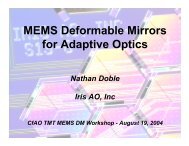PSF reconstruction for Keck AO - Laboratory for Adaptive Optics
PSF reconstruction for Keck AO - Laboratory for Adaptive Optics
PSF reconstruction for Keck AO - Laboratory for Adaptive Optics
You also want an ePaper? Increase the reach of your titles
YUMPU automatically turns print PDFs into web optimized ePapers that Google loves.
2 OTF CALCULATION 9where angular brackets denote ensemble average. Expanding the square and rearranging terms allows us to relatethe structure function to the correlation function C φ (ρ) =〈φ(x,t)φ(x + ρ,t)〉 assuming homogeneityD φ (ρ) =2[C φ (0) − C φ (ρ)] , (9)which will be eminently useful. If we assume (A3) that ɛ ‖ and φ ⊥ are statistically uncorrelated, then the structurefunction D ɛ of the residual phase error isD ɛ (x, ρ) =D φ⊥ (x, ρ)+D ɛ‖ (x, ρ), (10)where D φ⊥ is the structure function of everything that the <strong>AO</strong> system does not attenuate (i.e. the fitting error), andis estimated separately (see Sect. 3.2). With the definition (7) we have thatD ɛ‖ (x, ρ) ==〈∣ ∣∣∣∣ ∑N c2〉ɛ i (t)[h i (x) − h i (x + ρ)]∣i=1∑N c N ci=1 j=1One may define an aperture-averaged structure function ¯D(ρ) according to(11)∑〈ɛ i (t)ɛ j (t)〉 [h i (x) − h i (x + ρ)][h j (x) − h j (x + ρ)]. (12)¯D φ (ρ) =∫dx Dφ (x, ρ)P (x)P (x + ρ)∫dx P (x)P (x + ρ), (13)where P (x) defines the aperture transmission function. Since the autocorrelation in the denominator is band-limited,the fraction must only be computed within the support of ∫ dx P (x)P (x + ρ). The homogenized structure function¯D ɛ‖ can be written more simply as∑N c∑N c¯D ɛ‖ (ρ) = 〈ɛ i (t)ɛ j (t)〉 U ij (ρ), (14)where the U ij functions are given byi=1 j=1U ij (ρ) =∫dx [hi (x) − h i (x + ρ)] [h j (x) − h j (x + ρ)] P (x)P (x + ρ)∫dx P (x)P (x + ρ). (15)The static U ij functions can be computed <strong>for</strong> a given set of mirror modes h i (x), while the covariance matrix 〈ɛ i (t)ɛ j (t)〉is computed from the <strong>AO</strong> telemetry stream of DM actuator commands and WFS measurements during the particularobservation (see Sect. 3.4).Optical transfer functionLet K = K(α, β) be the anisoplanatic <strong>PSF</strong> as a function of image and object space angular coordinates (α, β),resulting from the anisotropic complex field ψ = ψ(x, y) in the image and object space spatial coordinates (x, y). Forincoherent quasi-monochromatic sources it can be shown [5] that the instantaneous <strong>PSF</strong> in the far-field approximationis given by K(α, β) =|F[ψ(x, y)]| 2 ,whereF denotes the Fourier trans<strong>for</strong>m. Since the OTF is B = F(K), it can beshown by the Wiener-Khinchin theorem that the long-exposure OTF is∫〈B(u, v)〉 = dw 〈ψ(w, v)ψ ∗ (w + u, v)〉, (16)where (u, v, w) are angular frequency coordinates of the OTF domain, and the superscript asterisk ( ∗ ) indicatescomplex conjugate. Assuming the field amplitude to be uni<strong>for</strong>m (A1) (and hence also isoplanatic), the complex fieldmay be described asψ(x, y) =P (x)exp[iφ(x, y)], (17)



